
Mechanism of MRET Treated Water Inhibition Effect on Morphology of Pathogenic Microorganisms: A Review
*Corresponding Author(s):
Igor SmirnovGlobal Quantech Sia, Latvia
Email:info@gqusa.com
Abstract
We found the significant protective properties of MRET water confirmed by substantial decrease of Staphylococcus aureus CFU (colony forming units) in homogenate of kidneys of mice on MRET water compared to control group of mice on regular water following the intra-peritoneal staphylococcal infection.
Another study relates to a detailed observation of the effect of MRET activated water with the modified molecular structure, physical and electrodynamic characteristics on metabolic activity and growth of conditionally pathogenic microbiological culture Escherichia coli K-12 (E.coli) and on metabolic activity of microbial associations (similar to microbial associations in the intestine). Activated (MRET) water produced significant changes of E.coli morphology: different shape, color and size of cells, disturbance of process of cellular division.
We also observed positive results of MRET water complimentary treatment for HIV patients during the clinical trial. There are recent research data which allows pointing to a similar mode of action for the two viral proteins, suggesting that anti-viral strategy that targets the viral-induced membrane fusion step can be adapted from HIV-1 to SARS-CoV. The stability of virus spike protein structure is based on the overall interactions of van der Walls weak electrodynamic forces and hydrogen bonding. It is obvious, that all biochemical formations of proteins require presence of water molecules in biological systems.
The overall observed research data suggest that modification of water - based medium electrodynamic parameters of the human tissues (that are favourable for the homeostasis of the body in the range of physiological “window”) can lead to significant change of van der Walls interactions and hydrogen bonding that result in the inhibition and interruption of virus spike proteins formation. Such scenario obviously disables virus life sequence of attachment and fusion with human cell membranes. The same type of mechanism can be adopted for the inhibition of other lines of pathogenic microorganisms. The studies conducted at AltheaDx Technology, USA confirm that MRET activated water based medium did not affect the morphology of normal PBMC cells on genetic level; it affected the morphology of normal PBMC cells in a positive way increasing their viability.
MRET Activated Water is produced with the help of patented in the USA Molecular Resonance Effect Technology (MRET, US Patent # 6022479). We suggest that MRET water consumption by human subjects can lead to physiologically favorable modification of dielectric permittivity and hydrogen bonding of water –based medium in the human body tissues. It can provide the initial human body natural defence against intervention and spread of pathogenic microorganisms
Keywords
Coronavirus; Dielectric permittivity; E. coli K-12; HIV-1; MRET water; Protein spike; Staphylococcus -aureus 46
INTRODUCTION
Recent genetic studies of different cell lines and primary cells provide convincing evidence of the bio-regulatory capabilities of magnetic and electromagnetic fields. Distinct changes in gene expression have been detected in cells after exposure to either radio-frequency EMF, Extremely Low Frequency (ELF) and static fields. Thus, the most important and certainly the most universal are non-thermal interactions of electromagnetic fields with cellular systems. In our view, most genetic and other bio-regulatory effects of weak magnetic fields (including geomagnetic field) can be achieved via the pair-radical mechanism of biological magnetoreception, first proposed by Schulten and coauthors [1].
Previous research revealed that coronaviruses invade cells through so-called “spike” proteins, but those proteins take on different shapes in different coronaviruses. Figuring out the shape of the spike protein in SARS-Cov-2 is the key to figuring out how to target the virus, said Jason McLellan, senior author of the study and an associate professor of molecular biosciences at the University of Texas at Austin. Though the coronavirus uses many different proteins to replicate and invade cells, the spike protein is the major surface protein that it uses to bind to a receptor - another protein that acts like a doorway into a human cell. After the spike protein binds to the human cell receptor, the viral membrane fuses with the human cell membrane, allowing the genome of the virus to enter human cells and begin infection. So “if you can prevent attachment and fusion, you will prevent entry,” McLellan told Live Science [2].
The scientists found that the protein-cleaving part of ACE2 binds the spike through polar interactions formed from a bridge-like structure on the enzyme. Both ends of the receptor binding domain stick to ACE2 through hydrogen bonding and weak electromagnetic van der Waals forces. Zhou’s research shows the subtle amino acid changes that create salt bridges and improve van der Waals interactions that might underlie this stronger interaction, he says [3].
HYPOTHESIS
Water is the natural background in the scope of which all biochemical processes are running. In nature, only four types of interactions (strong, weak, electromagnetic, and gravitational) are known. Two of the interactions are purely nuclear, and the gravitational one reveals itself only on the cosmic scale. Therefore, it is clear that only the electromagnetic interaction is essential in the scope of any biological system. For the sake of simplicity, we notice that the whole specificity of any biological process is eventually reduced to certain electromagnetic interactions. Just for this reason, the electromagnetic properties of water, which play the decisive role in its self-organization and in its influence on other objects, must be comprehensively investigated. These properties are revealed in all, without exception, biochemical and biophysical processes.
Specific features of the electrodynamic characteristics of water [first of all, a very great value of its dielectric permittivity ε (ω)] are the reason for the natural dissociation of molecules of many chemical compounds and the formation of the necessary ion composition of vitally important microelements. Otherwise, the normal operation of many systems of a living organism (in particular, the operation of selective membranes) would be impossible.
The change in the dispersive properties of water can render very strong influence (by means of modification of the electrostatic forces between separated charges and forces of the van der Waals type defining the interaction of the systems of neutral atoms and molecules) on the long range interaction of basic elements of living systems such as cells, viruses, biological macromolecules, enzymes, etc [4].
Though the coronavirus uses many different proteins to replicate and invade cells, the spike protein is the major surface protein that it uses to bind to a receptor - another protein that acts like a doorway into a human cell. After the spike protein binds to the human cell receptor, the viral membrane fuses with the human cell membrane, allowing the genome of the virus to enter human cells and begin infection.
The stability of spike protein structure is based on the overall interactions of van der Walls weak electrodynamic forces and hydrogen bonding. The pre-fusion spike protein stability needs certain medium that supports required van der Walls interactions and hydrogen bonding to form the protein spike chain by coronavirus. It is obvious, that such medium is a water-based one, since all biochemical formations of proteins requires presence of water molecules in biological systems. The following transition of pre-fusion spike protein to post-fusion protein also requires specific water-based medium to support correct transition and formation of the bridges to help coronavirus fuse with the human cell membrane.
The van der Waals forces among atoms and molecules generally act over relatively short distances, and are proportional to the inverse of the seventh power of the intermolecular distances for molecules and atoms. For two spheres of the same radius R, the interaction energy, W, as a function of the particle separation distance, D, is:

Where the Hamaker constant, A131, depends on the relative dielectric constants of the material 1 and medium 3.
The equation (1) yields for the significant role of the medium relative dielectric constant for the value of van der Waals interaction energy.
The interaction between the same objects (molecules) is determined by the dispersion van der Waals forces. The interaction energy, in the case of extended bodies including a great number of atoms and molecules, can be written as:

The quantity (r) depends on the distance r between the surfaces of these objects (molecules), the spectrum of the total dielectric permittivity of water εW(ω), and the corresponding spectra of the dielectric permittivity εj(ω) and εk(ω) of the interacting objects (molecules). Here, = 2πc/r is the maximum frequency of the fluctuating electromagnetic field which should be accounted in the calculation of the van der Waals interaction energy between two bodies (objects) with volumes Vk and Vj.
It is seen from equation (2) that the final character of the interaction between any bodies (molecules), its sign, and the intensity depend on the spectrum of the dielectric permittivity of these bodies and the water-salt medium in the region between them. They also depend on the distance between bodies. Typical, for example, is the situation where εj(ω)> εw(ω) and εk(ω)>εw(ω) in some part of the spectrum; and εj(ω)>εw(ω) and εk(ω) < εw(ω) or εj(ω)< εw(ω) and εk(ω)>εw(ω) in other parts. This indicates that the integrand in equation (2) becomes an alternating function of the frequency. This allows us to conclude that the controlled change in the dispersion characteristics of the water-salt medium separating the interacting objects gives the possibility to influence the sign and the intensity of the interaction between bodies. In particular, a change of the dielectric permittivity of water can stimulate the mutual attraction of, for example, viruses and cells, but can also favor their mutual repulsion at large distances [4].
The equation (2) indicates that weak electromagnetic van der Walls interactions in aqueous liquids directly depend on relative dielectric permittivity of water. The formation of any protein structures in the human body strictly depends on specific balance of dielectric property of protein molecules and water since it provide certain parameters of van der Walls forces to build such proteins. Dielectric property of water in its turn depends on temperature. We know from medicine that normal homeostasis of the human body is allowed at the precise physiological temperature parameters of the body: 35° C - 41° C on general basis. The drop of the body temperature below 35°C as well as the rise of the body temperature above 41° C leads to the inability to sustain life. There are research data indicating relation between dielectric constant of the human body tissue (TDC) and temperature: 35° C - 74.9 F/m (TDC) and 40° C - 73.2 F/m (TDC) (Figure 1). It shows that normal homeostasis of the human body is allowed at certain range of electodynamic van der Walls interactions following the small range of tissue dielectric property about 75 - 73 F/m. It is well correlated since we know from physics that relative dielectric permittivity of water is 80 F/m at room temperature (20° C).
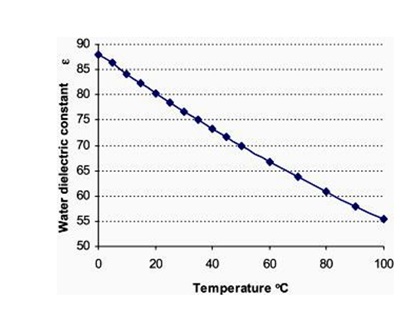 Figure 1: Water dielectric constant dependence on temperature.
Figure 1: Water dielectric constant dependence on temperature.
It allows us to suggest that dielectric property of human body tissue is very important physiological parameter. For example, for the full band of frequencies analyzed, the dielectric constant of malignant colon tissue is on average 8.8% higher (Figure 2) than the dielectric constant of healthy one (p = 0.002). This difference is even higher at frequencies below 4 GHz [5].
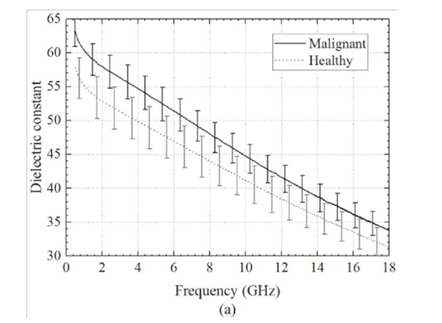
Figure 2: Mean of the dielectric constant (a) of healthy and malignant colon tissue, along with their standard deviation in error bar format [5].
It is remarkable that, while the enthalpy of protein unfolding, ?H (T) is a linear function of temperature, the entropy factor, T?S (T), is not quite linear. Therefore, these two functions change with temperature in an almost parallel fashion, but at temperatures close to physiological the enthalpy function slightly prevails over the entropy factor; however, at higher and lower temperatures the entropy factor starts to prevail. Their difference:
 ?G (T) is the Gibbs energy, which represents the work required to transfer protein from the folded to the unfolded state. This Gibbs energy is, therefore, usually regarded as a measure of protein structure stability. It appears then that at physiological temperatures protein structure is stable: however, on temperature increase or decrease the difference between the enthalpy and entropy factor reduces and then changes sign. Thus, the native protein structure becomes unstable both above and below this optimal temperature, which is in the physiological range. Specifically, the stability of myoglobin at physiological temperatures amounts to about 30 kJ/mol. At this temperature the energy of thermal motion reaches the value:
?G (T) is the Gibbs energy, which represents the work required to transfer protein from the folded to the unfolded state. This Gibbs energy is, therefore, usually regarded as a measure of protein structure stability. It appears then that at physiological temperatures protein structure is stable: however, on temperature increase or decrease the difference between the enthalpy and entropy factor reduces and then changes sign. Thus, the native protein structure becomes unstable both above and below this optimal temperature, which is in the physiological range. Specifically, the stability of myoglobin at physiological temperatures amounts to about 30 kJ/mol. At this temperature the energy of thermal motion reaches the value:
RT = 8.3 J/K mol x (37 + 273) K= 2.5 kJ/mol
i.e., the protein stability at this physiological temperature is one order of magnitude higher than the energy of thermal motion. This is enough for the protein to withstand the disruptive action of thermal motion. It is notable, however, that the stability of protein structure is not too high. It appears that globular proteins just do not need an excessive stability, but some flexibility of structure is required, perhaps for proper functioning. Hydrogen exchange studies of such proteins indeed show that their structure fluctuates at physiological temperatures, but these are just independent micro-unfolding of its structure. The most surprising result of this thermodynamic analysis is that protein stability decreases not only upon heating, but also upon cooling from physiological temperatures, and thus one should expect proteins to denature not only on heating, but also on cooling [6,7].
Thus, normal healthy homeostasis of the human body directly depends on physiological temperatures “window”, and subsequently relative dielectric permittivity of the body liquids should be kept in the physiological range “window” of about 75 -73 F/m. Any type of shifting from this range may lead to development of diseases including body infection with pathogenic microorganisms. Considering mentioned above ideas, it allows us to hypothesize that most of biochemical proteins building mechanisms in a healthy human body require certain physiological range “window” of van der Waals interactions and hydrogen bonding between proteins molecules and water - salt medium. In theory, this physiological “window” of van der Waals weak electromagnetic forces may be significantly different from the range of electrodynamic van der Waals interactions required for life sustains formations of DNA/RNA proteins of viruses, bacteria and other pathogenic microorganisms. The same type of general mechanism can be adopted for other lines of bacteria and viruses as well.
Thus, modification of water - based medium electrodynamic parameters of the human tissues that are favorable for the homeostasis of the body ( in the range of physiological “window”) can lead to significant change of van der Walls interactions and hydrogen bonding that may result in the inhibition and interruption of proper formation of spike proteins chains. Such scenario obviously disables coronavirus life sequence of attachment and fusion with human cell membranes.
We suggest such agent which can interrupt pathogenic microorganism’s life sequence is MRET water with anomalous electrodynamic characteristics. MRET water can be consumed on the regular basis by human subjects to prevent infections of pathogenic microorganisms.
The studies conducted at AltheaDx Technology, USA confirm that MRET activated water based medium did not affect the morphology of normal PBMC cells on genetic level; it affected the morphology of normal PBMC cells in a positive way increasing their viability [8].
A number of studies in vivo and in vitro regarding MRET activated water effects confirm that it does not affect the genetic characteristics of living organisms. In all the analyzed cases, no reliable case of a change in specific characteristics of organisms was registered. That is, MRET Activated water is safe for the action on the genetic apparatus. MRET water effects concern only the quantitative characteristics of the development of biological systems (the acceleration or inhibition of the growth of cells and biomass).
MRET Activated Water is produced with the help of patented in the USA Molecular Resonance Effect Technology (MRET, US Patent # 6022479). MRET water activator is the stationary source of subtle, low-frequency, resonant electromagnetic field with composite structure. The origin of the low-frequency composite electromagnetic field is the intensive electrical activity inside the nano-circles formed by linear molecular groups of MRET polymer compound (volumetric fractal geometry matrix) when polymeric body is exposed to the external electromagnetic fields of specific frequency and wavelength. The significant reduction of values of electrical conductivity and dielectric permittivity confirms the relatively high, long-range dynamic structuring of water molecules in activated water produced with the help of MRET activation process. The long-term storage of activated water (up to 5 hours at 20?C) did not significantly affect its modified electrodynamic characteristics, thus confirming the ability of MRET activated water to keep its anomalous properties for rather long period of time in case of 30 minutes activation, and even higher level of “long-term water memory” phenomenon in case of 60 minutes activation. The significant level of reduction of dielectric permittivity and electrical conductivity kept by MRET water activated for 30 minutes after it was heated to 72?C confirms its stability to thermal effects. It demonstrates the anomalous behavior of electrodynamic characteristics (dielectric permittivity and electrical conductivity) of MRET water subject to applied EMF (electromagnetic field) in the area of very low range of frequencies in order to provide some evidence regarding polarized-oriented multilayer structuring of MRET activated water and the possible effect of MRET water on the proper function of cells in biological systems.
PROOF OF HYPOTHESIS
(I). The research was conducted under supervision of Prof. Vladimir I. Vysotskii and Prof. Lydia S. Kholodna, at Faculty of Microbiology and Immunology, Biological Department of Kyiv National Shevchenko University, Ukraine in 2004.
The significant protective properties of MRET water were confirmed by substantial decrease of Staphylococcus CFU (colony forming units) in homogenate of kidneys of mice on MRET water compared to control group of mice following the intra-peritoneal staphylococcal infection after the first 24 h. For this purpose the kidneys of animals were dealt individually. The analysis of data in the beginning of experiments leads to the conclusion that significant decrease of pathogen’s colonies in homogenate of kidneys of mice on MRET water begins only after 24 h following the inoculation of S. aureus. The significant protective properties of MRET water were confirmed by substantial decrease of Staphylococcus CFU (colony forming units) in homogenate of kidneys of mice on MRET water compared to control group of mice following the intra-peritoneal staphylococcal infection after the first 24 h. For this purpose the kidneys of animals were dealt individually. The analysis of data in the beginning of experiments leads to the conclusion that significant decrease of pathogen’s colonies in homogenate of kidneys of mice on MRET water begins only after 24 h following the inoculation of S. aureus. The consumption of MRET water reduced the death rate from 30% (control group) to 0% (MRET groups) during the first 9 days of experiment. There was no case of animal death in all investigated groups within the first 24 h after intra-peritoneal inoculation of Staphylococcus culture, which is a pretty standard result. During the next 8 days 30% of animals died in control group which is an expected result for such experimental procedure. There was no death case in both groups of mice that ingested MRET activated water and it is a very unusual result. Nevertheless, the main consequences of Staphylococcus infection do not manifest in death of animals as in case of oncology diseases. Staphylococcus bacteria affect the live systems and organs of the body. These pathogenic microorganisms cause inflammations, suppurations, abscesses, furuncles, quinsy, cepsical conditions, etc. That’s why a detailed investigation of the process of stimulation by MRET water of phagocytes and of lymphoid organs of immune system of mice infected with S.aureus culture was conducted and is presented in this report.
The local inflammation was induced with the help of the inoculation of S. aureus culture into the hind left paw. The ordinary inflammatory reaction was observed in the group of mice on non-activated water: the intensive reddening of the hind left paw (Figure 3). Both groups of mice on MRET water did not develop any reddening of the hind left paw inoculated with S. aureus culture (Figure 4). The results of this experiment confirm the fact of the substantial inhibition of inflammatory infection in case of the regular consumption of MRET water.
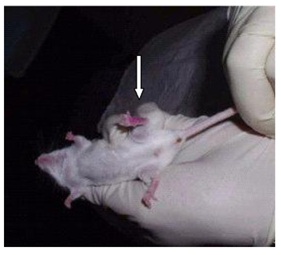
Figure 3: The view of paws of a mouse on non-activated water (reddening of the injected paw) in 24 hours after the injection of Staphylococcus culture.
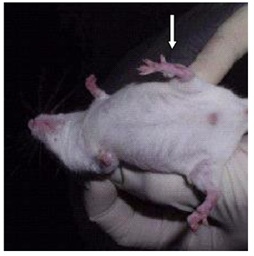
Figure 4: The view of paws of a mouse on MRET activated water (no reddening of the injected paw) in 24 hours after the injection of Staphylococcus culture.
Phagocytosis is the main mechanism of natural resistance especially at the first stage of contagious process; it is a regular part of formation of the specific immune response. The most common methodology applied in the studies of the functional activity of phagocytes is the examination of their phagocytic (engulfing of alien cells) and oxygen dependent bactericidal activity. Phagocytic activity of neutrophils and macrophages is estimated based on Phagocytic Index (percentage of phagocytes which engulfed test-bacteria) and on Phagocytic Number (average number of test-bacteria engulfed by one phagocyte).
The cultures of S. aureus and Latex are usually used as test-bacteria. The oxygen-dependent bactericidal activity of phagocytes is studied with the help of NBT-test: an oxygen-dependent reduction of Nitro Blue Tetrazolium into an insoluble Diformazan of Nitro Blue Tetrazolium derivative by phagocytes. With the help of NBT-test it is possible to distinguish the activated phagocytes from the non-activated ones. MRET water stimulated the phagocytic capacities of neutrophils of a peripheral blood and peritoneal macrophages increasing their phagocytic activity, particularly Phagocytic Index (Figure 5) and Phagocytic Number (Figure 6).
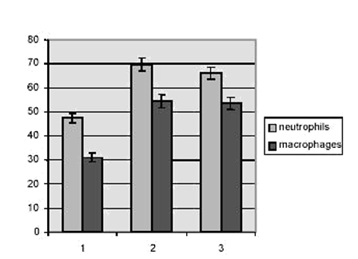 Figure 5: Phagocytic Index of neutrophils and macrophages in two weeks of experiment (object of phagocytosis - Staphylococcus aureus): 1 - Control group; 2 - Mice on MRET water (preventive for 4 weeks); 3 - Mice on MRET water (preventive for 2 weeks).
Figure 5: Phagocytic Index of neutrophils and macrophages in two weeks of experiment (object of phagocytosis - Staphylococcus aureus): 1 - Control group; 2 - Mice on MRET water (preventive for 4 weeks); 3 - Mice on MRET water (preventive for 2 weeks).
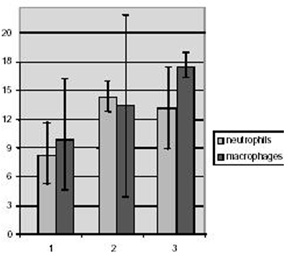 Figure 6: Phagocytic Number of neutrophils and macrophages in two weeks of experiment (object of phagocytosis - Staphylococcus aureus) : 1 - Control group; 2 - Mice on MRET water (preventive for 4 weeks); 3 - Mice on MRET water (preventive for 2 weeks).
Figure 6: Phagocytic Number of neutrophils and macrophages in two weeks of experiment (object of phagocytosis - Staphylococcus aureus) : 1 - Control group; 2 - Mice on MRET water (preventive for 4 weeks); 3 - Mice on MRET water (preventive for 2 weeks).
At the end of two weeks of experiment the mean values of studied parameters in both groups of mice on MRET water substantially increased compared to the control group. The differences in mean values of the parameters of functional activity of phagocytes of groups of mice consuming MRET water compared to the control group of mice on non-activated water were statistically significant with p < 0.05 (for Phagocytic Index and NBT-test). These results confirm the significant intensification of phagocytic and bactericidal activity and of immune system response following the consumption of MRET water [9].
The in vivo experiment revealed that the mean values of studied parameters in both groups of mice on MRET water (preventive for 4 and 2 weeks respectively) significantly increased compared to the control group. The differences in mean values of the studied parameters of the groups of mice consuming MRET water compared to the control group of mice on non-activated water were statistically significant with p < 0.05 (for most of the parameters). Particularly, the consumption of MRET water reduced the death rate from 30% (control group of mice on non-activated water) to 0% (two groups of mice on MRET water) during the first 9 days of experiment after intra-peritoneal inoculation of Staphylococcus culture. The significant bacteriostatic effect of 70 - 100% (depending on initial concentrations of pathogens) was observed in vitro for MRET-activated nutrient medium in this investigation. These results confirm the significant intensification of phagocytic activity and of immune system response following the consumption of MRET water.
(II). The clinical observation was performed at Thammarakniwet Foundation, WAT Phrabaat Namphu, Lopburi Province, Thailand. The investigation was conducted under supervision of Dr. Peerayot Trongsawad, MD, Director of AIDS Control Department, Bangkok Metropolis.
The study was conducted on 38 AIDS patients during August, 2004 - August, 2005. All patients were consuming 1.5 liters of MRET activated water per day as a complimentary treatment in addition to the prescribed Anti-HIV medications. During the course of clinical observation all 38 patients were tested on a regular basis for CD4 counts and required to submit weekly reports regarding their health conditions.
There was simultaneous observation of other group of AIDS patients during the same period of time (control group). They were on the same type of prescribed Anti-HIV medication, but without the complimentary consumption of MRET water [10].
First method: collection and analysis of the weekly health condition reports and CD4 counts reports;
Second method: group interviews and personal interviews with patients which participate in this observation.
38 patients of the age between 19 and 49 years old were selected for the clinical trial. Summarizing the observation results we can indicate that in compliance with the studied gradations of AIDS patients health conditions 36 patients showed significant improvement and 2 patients did not show any improvement of their health condition.
Two patients were selected to undergo two tests at the Bangkok Pathology Laboratories due to budget limitation. One test was the reading of the level of CD4 counts (immune system) and the other was Viral Load (the amount of virus in the body) For CD4 reading, a healthy body should have a range of 800 – 1200 cells / microliter.
For Viral Load, the instrument has the ability to measure from 50 - 5000 copies / ml. The lower the number, the lesser the virus in the body, and subsequently lesser it attacks the patient’s body.
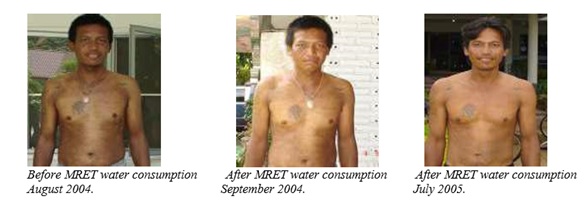
1st Patient Mr. Sa-ad: His CD4 counts increased from 2 to 840 within 11 months of consumption of MRET activated water. His Viral Load was less than 50.
2nd Patient Mr. Un-ruang: His CD4 counts increased from 90 to 805 within 3 months of consumption of MRET water. His Viral Load was also less than 50.
Group of patients without MRET water treatment: The simultaneous observation of the patients which did not consume MRET water (control group) provides evidence that these patients did not show any significant improvement of their health condition.
Severe Acute Respiratory Syndrome (SARS) is a febrile respiratory illness. The disease has been etiologically linked to a novel coronavirus that has been named the SARS-Associated Coronavirus (SARS-CoV), whose genome was recently sequenced. Since it is a member of the Coronaviridae, its spike protein (S2) is believed to play a central role in viral entry by facilitating fusion between the viral and host cell membranes. The protein responsible for viral-induced membrane fusion of HIV-1 (gp41) differs in length, and has no sequence homology with S2. Infection by many enveloped viruses requires fusion of the viral and cellular membranes. A viral envelope protein mediates this membrane fusion process. These proteins are synthesized as precursors (ENV in Retroviridae, and E2 in Coronaviridae) that are later processed into a transmembrane subunit (gp41 in the retrovirus HIV-1, and S2 in the coronavirus SARS-CoV) that is responsible for viral-induced membrane fusion, and a surface subunit that is responsible for the interaction with the cellular receptor/s. This study points to a similar mode of action for the two viral proteins, suggesting that anti-viral strategy that targets the viral-induced membrane fusion step can be adapted from HIV-1 to SARS-CoV [11].
It clearly indicates that MRET activated water consumption may be applicable for prevention and a complimentary treatment of patients suffering from SARS-CoV type of disease as well.
(III) This study relates to a detailed observation of the effect of MRET activated water with the modified molecular structure, physical and electrodynamic characteristics on metabolic activity and growth of conditionally pathogenic microbiological culture Escherichia coli K-12 (E.coli) and on metabolic activity of microbial associations (similar to microbial associations in the intestine). The research was conducted under supervision of Prof. Vladimir Vysotskii (Kiev State University, Ukraine), Alexander Tashyrev, Ph.D., Anna Tashireva, Ph.D. (Kiev Institute of Microbiology and Virology of Ukrainian Academy of Science), in 2004.
The goal of this investigation was to study the effect of MRET water activated for different periods of time (30 and 60 minutes respectively) on metabolic activity and growth of conditionally pathogenic microbial culture Escherichia coli K-12 in aerobic and anaerobic environment and on microbial associations in anaerobic environment. The study revealed the significant inhibition of growth and metabolic activity of E.coli bacteria in aerobic environment. It confirms that the process of MRET activation and the sterilization effect of MRET water can be applied in food industry and for water purification.
This investigation revealed the significant inhibition effect of MRET-activated nutrient medium in aerobic environment on the process of growth and reproduction of E.coli microorganisms, their division, the size of colonies and the modification of forms of culture cells. It was observed that at low initial concentration of cells of investigated culture Escherichia coli K-12 MRET nutrient medium activated during 30 minutes and 60 minutes inhibited the growth of culture 27 and 303 times respectively during the 25 hours of experiment (Figure 7).
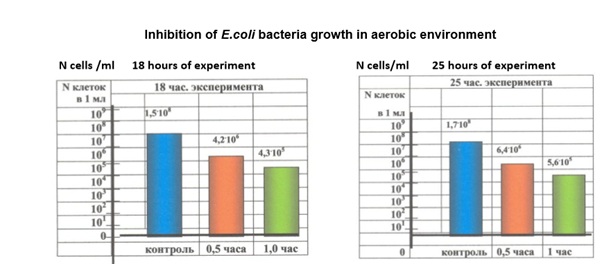
Figure 7: The inhibition of E.coli growth in aerobic environment: 303 times (tact=1.0hour) and 27 times (tact=0.5hour) after 25 hours of experiment (blue color - control, red - 30 minutes and green - 60 minutes MRET-activated medium).
It was observed that one of the reasons of abnormally low growth of E.coli population was related to the modification of the process of cell division in MRET-activated nutrient medium (Figure 8).

Figure 8: The experiment was conducted on E. coli bacteria in the aerobic environment. Picture #1 - control sample after 24 hours of incubation. Picture #3 - activated sample (60 minutes activation) after 24 hours of incubation. I9 - index of abnormal cellular division. Control sample I9 = 4%; 60 minutes activation sample I9 =220%. Activated (MRET) water produces significant changes of E.coli morphology: different shape, color and size of cells, disturbance of process of cellular division. . Adaptation mutation of E.coli cells. /1/ - normal cellular division; /2/ - abnormal cellular division.
These results allow admitting that the process of MRET activation and the sterilization effect of MRET water can be applied in food industry and for water purification. The second stage of investigation revealed that the metabolic (reductant) activity of E.coli bacteria reduced up to 3 times in 30 minutes activated water and up to 1.6 times in 60 minutes activated water during the first 6 hours of experiment in aerobic environment.
Another experiment showed that the process of MRET-activation did not affect the reductant activity of E.coli bacteria in anaerobic environment and, consequently, should not affect a small population of conditionally pathogenic bacteria, such as E.coli, usually presented in microbial associations in the intestine of the body. In order to simulate the environmental conditions similar to the conditions in the intestine of humans and animals the test on metabolic activity of microbial associations was conducted in anaerobic environment. Reductant activity is an integral characteristic of metabolic activity of microorganisms and it is measured with the help of Sodium Resasurine color indicator in the percentage degree of discoloration (purple = 0%, red = 50%, transparent = 100%). It was found that MRET-activated water substantially increased reductant activity of complex microbial associations during the first nine hours of experiment (Figure 9).
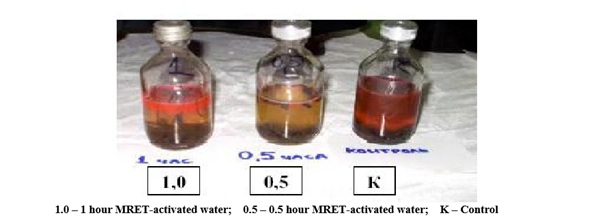
Figure 9: Comparative test on metabolic (reductant) activity of microbial associations (1.0 hour and 0.5 hour MRET- activated water and K-Control samples) in anaerobic environment.
This experiment revealed that the optimum time of activation for the maximum increase of metabolic activity of microbial associations in anaerobic environment was 30 minutes. The same optimum time of activation was found in the process of inhibition of metabolic activity of E.coli in aerobic environment [12].
It could be expected a priori that activated water must have some anomalous chemical properties for the manifestation of such strong influence. However, the comprehensive studies showed that water after the activation has the same chemical composition and almost the same hydrogen index (pH), contains the same small amount of free radicals, and has no induced radioactivity. But some of its physical characteristics have varied after the activation. In particular, the conductivity, dielectric permittivity, density, and viscosity have become different. It is extremely important to determine how such changes can affect the character of the interrelation of water and the elements of a living system, as well as the very functioning of a living organism. The further perspective of the application of activated water as a very powerful tool of life-protecting biotechnologies depends on both the degree of its comprehension and the reliability of its applications.
CONCLUSION
We observed positive results of MRET water complimentary treatment for HIV patients during the clinical trial conducted at Thammarakniwet Foundation, WAT Phrabaat namphu, Lopburi Province, Thailand in 2004 -2005. The recent research data allows pointing to a similar mode of action for the two viral proteins, suggesting that anti-viral strategy that targets the viral-induced membrane fusion step can be adapted from HIV-1 to SARS-CoV.
We found in vivo and in vitro experiments that MRET water consumption can significantly inhibit growth and reproduction cycle of Staphylococcus areus -46 culture and E. coli culture. It allows us to conclude that consumption of MRET activated water significantly enhances the factors of natural resistance of the body which constitute the first line of protection of an organism against the penetration and reproduction of pathogenic microorganisms.
We propose mechanism that consumption of MRET water by human subjects can lead to the physiologically favourable modification of dielectric permittivity and hydrogen bonding of water-based medium of the human body tissues, keeping the optimum physiological range of tissues dielectric constant. It results in the significant modification of van der Walls interactions and hydrogen bonding of water-based medium. Those leads to the inhibition and interruption of virus spike proteins formation. Such scenario obviously disables virus life sequence of attachment and fusion with human cell membranes. The same type of general mechanism can be adopted for other lines of bacteria and viruses as well. It can provide the initial human body natural defense against intervention and spread of pathogenic microorganisms.
REFERENCES
- Wrapp D, Wang N, Corbett KS, Goldsmith JA, Hsieh CL, et al. (2020) Cryo-EM structure of the 2019-nCoV spike in the pre-fusion conformation. Science 367: 1260-1263.
- Satyanarayana M (2020) Researchers in China report structure of the novel coronavirus bound to its human target. American Chemical Society, USA.
- Yossef Kliger, Erez Y Levanon (2003) Cloaked similarity between HIV-1 and SARS-CoV suggests an anti-SARS strategy. BMC Microbiol 3: 20.
- Smirnov I, Trongsawad P (2010) The Clinical Observation of MRET Activated Water Effect on Patients Suffering from AIDS. Asian J Exp Biol Sci Vol: 1.
- Vysotskii V, Kornilova A, Smirnov I (2009) Applied Biophysics of Activated Water: The Physical Properties, Biological Effects and Medical Applications of MRET Activated Water”, World Scientific Pub Co Inc., Singapore.
- Smirnov I (2010) The comparative analysis of the effect of MRET treatment on morphology of HeLa cancer cells and PBMC normal cells. Am J Sci Ind Res 1: 25-28.
- Fornes-Leal A, Garcia-Pardo C, Frasson M, Pons Beltrán V, Cardona N (2016) Dielectric characterization of healthy and malignant colon tissues in the 0.5-18 GHz frequency band. Phys Med Biol 61: 7334-7346.
- Privalov PL, Crane-Robinson C (2017) Role of water in the formation of macromolecular structures. Eur Biophys J 46: 203-224.
- Hvidt A, Nielsen SO (1966) Hydrogen exchange in proteins. Adv Protein Chem 21: 287-386.
- Smirnov I (2009) The effect of MRET activated water on staphylococcal infection in vivo in animal model and in vitro on the culture of Staphylococcus aureus wood-46. Applied Biophysics of Activated Water Page no: 252-283.
- Smirnov I (2008) The Effect of MRET Activated Water on Microbiological Culture Escherichia coli K-12 and on Complex Microbiological Associations. Explore! Vol: 17.
- Zaporozhan V, Ponomarenko V (2010) Mechanisms of Geomagnetic Field Influence on Gene Expression Using Influenza as a Model System: Basics of Physical Epidemiology. Int J Environ Res Public Health 7: 938-965.
Citation: Smirnov I (2020) Mechanism of MRET Treated Water Inhibition Effect on Morphology of Pathogenic Microorganisms: A Review. J Clin Stud Med Case Rep 7: 087.
Copyright: © 2020 Igor Smirnov, et al. This is an open-access article distributed under the terms of the Creative Commons Attribution License, which permits unrestricted use, distribution, and reproduction in any medium, provided the original author and source are credited.

